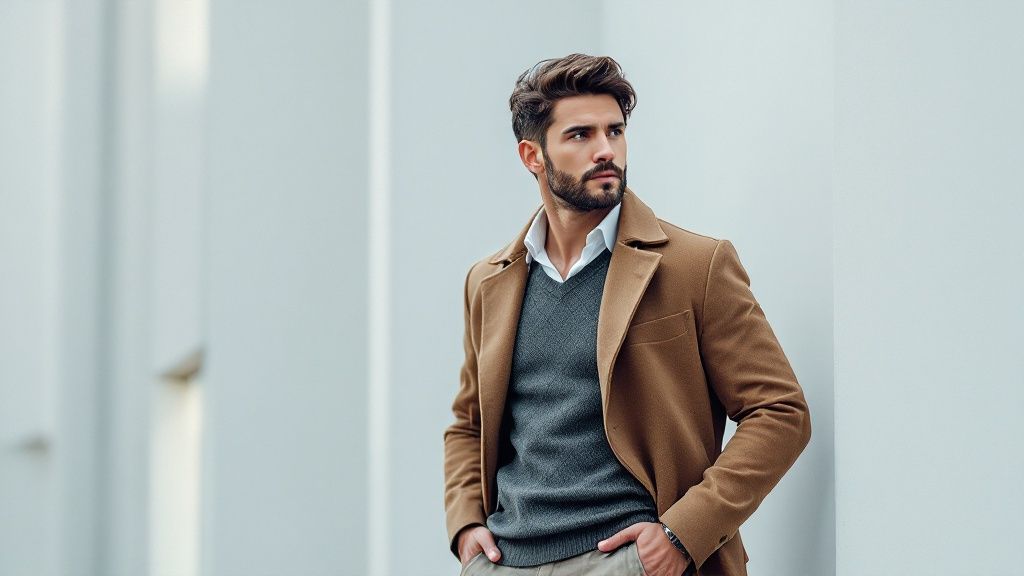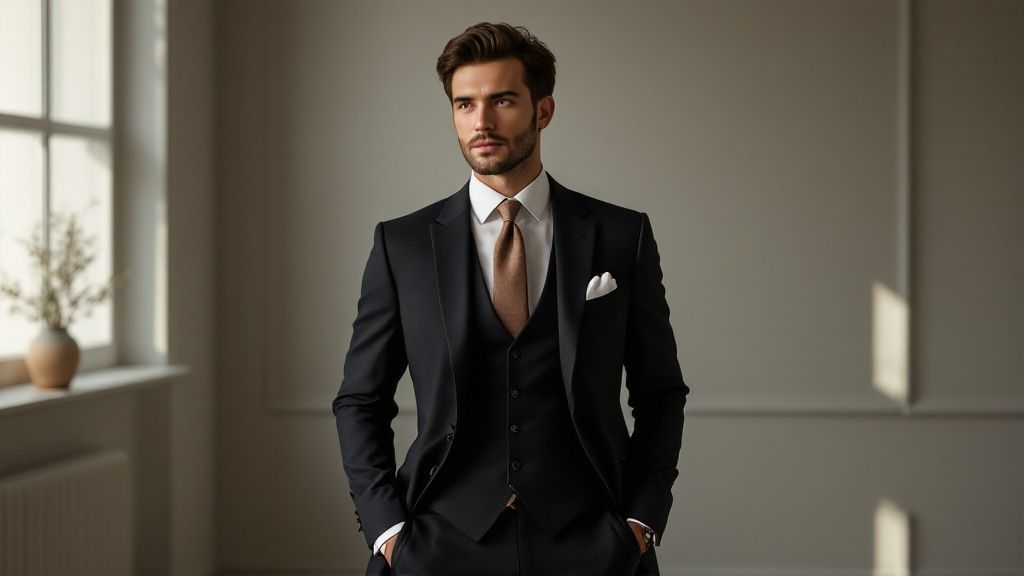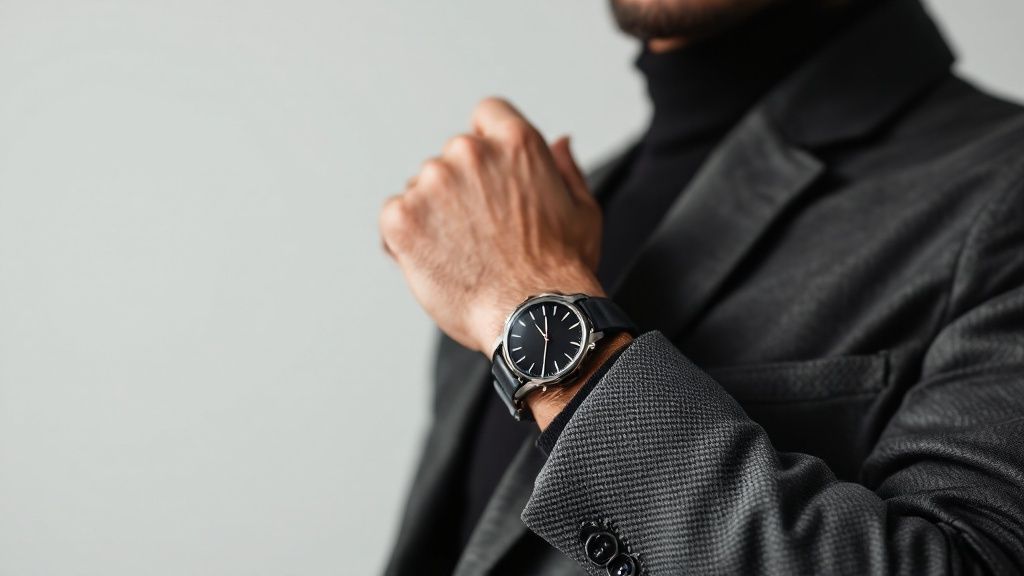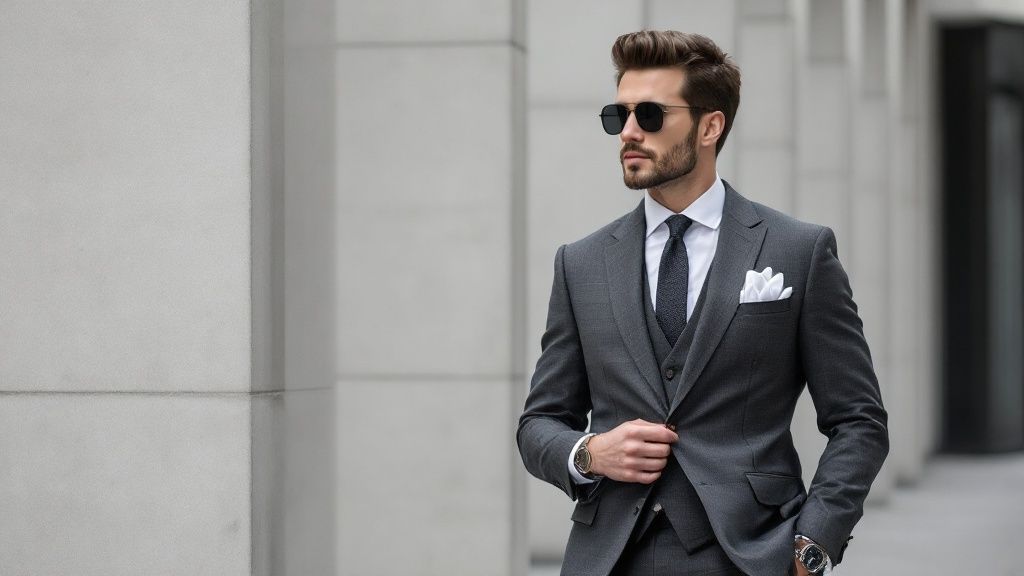Mastering the Building Blocks of Men's Style

Starting your menswear journey begins with understanding your personal aesthetic. A great starting point is this article on how to find your style. This knowledge is the foundation of a wardrobe that truly represents you. Understanding fit, color, and fabric are essential for creating a versatile and stylish collection of clothing. These core elements are the building blocks of a sharp appearance.
Understanding Fit: The Cornerstone of Men's Style
Fit is paramount. It's the most important factor in how clothing looks on you. A poorly fitting garment can cheapen even the most expensive brands, while a well-fitted piece elevates even basic items.
Understanding your body shape and proportions is key for making the right clothing choices. For instance, a slim-fit shirt accentuates a lean physique, while a classic fit offers more room for broader shoulders. Getting the fit right is crucial for looking your best.
Decoding Color: Creating Visual Harmony
Beyond fit, color is vital for a stylish look. Mastering color combinations can dramatically improve your appearance. This involves understanding which colors complement your complexion. It also means learning how to create visually appealing outfits.
A classic example is a navy blazer paired with khaki chinos – a timeless and sophisticated combination. Learning basic color theory can open up a world of more adventurous and stylish pairings.
Fabric Focus: Quality and Versatility
Fabric choice impacts both comfort and how you look. Choosing the right fabrics can elevate your style and ensure long-lasting wear. Certain fabrics offer more versatility across seasons.
Linen, for example, is breathable and ideal for summer. Wool, on the other hand, provides warmth during colder months. Choosing quality fabrics is an investment in both style and practicality.
Speaking of investment, the menswear market has seen impressive growth, reaching US$545 billion in 2023. It's projected to reach US$950 billion by 2033. Find more detailed statistics here. This growth reflects a growing emphasis on quality and style in menswear. By focusing on these core elements – fit, color, and fabric – you can build a wardrobe that not only looks great but also stands the test of time.
Creating a Capsule Wardrobe That Actually Works

A capsule wardrobe isn’t just a passing trend; it’s a smart, practical approach to men's fashion. It's all about getting the most out of a smaller number of well-chosen clothes. This method streamlines your morning routine, ensuring you're always stylishly dressed. Let's explore how to build a capsule wardrobe that truly works for you.
The Psychology of a Successful Wardrobe
A capsule wardrobe hinges on interchangeability. Every item should work with several others, multiplying your outfit options. Focus on neutral colors and classic styles as your foundation. For a great starting point on core menswear, check out these essential pieces every guy should own. This approach maximizes impact with fewer items.
For instance, a navy blazer can be dressed up with dress pants and a tie, or dressed down with jeans and a t-shirt. This versatility is crucial for a functional capsule wardrobe. Investing in high-quality, durable pieces also extends the life of your wardrobe, reducing the need for constant replacements.
Choosing Versatile Pieces
Versatility reigns supreme when building a capsule wardrobe. Pick items that can be dressed up or down, suitable for different situations. This helps you avoid pieces you'll only wear for specific events. A well-curated capsule wardrobe eliminates the need for a massive clothing collection.
Prioritize neutral colors like navy, gray, black, and white. These colors act as a base, making it easy to mix and match. Don't shy away from adding splashes of color with accessories or accent pieces to personalize your look without compromising versatility.
Building Your Personalized Capsule Wardrobe
Your capsule wardrobe should reflect your lifestyle and personal needs. A businessman’s wardrobe will naturally differ from a creative professional's. Consider your daily routine, work environment, and social calendar when choosing items to ensure your wardrobe aligns with your everyday life.
-
Evaluate your current wardrobe: What do you wear the most? Notice any common themes? This reveals your style preferences.
-
Create a list of essentials: This will vary based on your lifestyle, but some common essentials include a navy blazer, dark-wash jeans, white button-down shirts, and versatile shoes.
-
Gradually build your collection: Start with the basics, adding pieces strategically over time. This allows you to refine your style and avoid impulse buys.
The following table provides a starting point for essential wardrobe items:
Essential Men's Wardrobe Items
A comprehensive breakdown of the foundation pieces every man should own for a complete, versatile wardrobe
| Clothing Category | Essential Items | Recommended Quantity | Versatility Rating |
|---|---|---|---|
| Tops | White button-down shirt, Navy blue T-shirt, Gray crewneck sweater | 2-3 each | High |
| Bottoms | Dark wash jeans, Chinos (khaki or navy), Dress pants (gray or navy) | 2 each | High |
| Outerwear | Navy blazer, Versatile jacket (e.g., bomber, Harrington) | 1-2 each | Medium-High |
| Shoes | Leather dress shoes, White sneakers, Casual boots | 1-2 each | Medium |
| Accessories | Belts (brown and black), Ties, Pocket squares | 2-3 each | Medium |
This table outlines the core pieces for a functional and stylish wardrobe. The recommended quantities and versatility ratings offer guidance, but adjust based on your specific needs and preferences.
By following these tips, you’ll create a capsule wardrobe that simplifies your life and maximizes your style. This curated approach ensures you're always well-dressed without the burden of a large, unwieldy wardrobe.
Elevating Your Professional Presence Through Formal Wear

The difference between looking good and looking truly exceptional in formal wear often comes down to the small details. These subtle nuances speak volumes about your attention to quality and style. By understanding these elements, you can significantly elevate your professional image. This guide will explore the crucial aspects of mastering formal wear.
The Power of Precise Fit
Fit is paramount when it comes to impactful formal wear. It's more than just choosing the right size. Precise fit hinges on understanding how specific measurements influence your overall appearance. A well-fitted suit, for example, should embrace your shoulders comfortably without constriction.
The jacket sleeves should ideally end just above the wrist bone, revealing a hint of your shirt cuff. This attention to detail extends to your shirt and trousers. A properly fitted shirt allows ease of movement without excess fabric.
Trousers should break neatly over your shoes, creating a streamlined and polished look. Mastering these seemingly minor adjustments dramatically enhances your overall presentation, projecting an image of confidence and sophistication. These details allow your clothing to complement your physique, not overpower it.
Understanding the Psychology of Formal Wear
Clothing speaks a silent language. In professional settings, this unspoken communication significantly influences how others perceive you. A dark navy suit, for instance, projects an aura of authority and competence. A lighter gray suit, on the other hand, can convey a sense of approachability.
Your choice of tie, shirt color, and even your shoes all contribute to this non-verbal dialogue. Understanding the psychological impact of clothing empowers you to dress strategically for different occasions. A high-stakes meeting necessitates a different approach than a casual networking event.
By carefully considering your attire, you can subtly shape perceptions and project the desired image. This awareness is a powerful asset in any professional’s toolkit.
Decoding Dress Codes: From Casual Friday to Black Tie
Navigating dress codes can be a minefield. Terms like "business casual" or "semi-formal" often leave people uncertain about what's truly appropriate. However, understanding these codes is essential to avoid wardrobe mishaps that can detract from your professional image.
Here’s a quick guide to common dress codes:
- Business Casual: Consider chinos or khakis, a button-down shirt (tie optional), and a blazer or sport coat.
- Semi-Formal: A suit in a darker color is usually a safe choice.
- Business Formal: This typically calls for a dark suit, a dress shirt, and a tie.
- Black Tie: A tuxedo is the standard for black-tie affairs.
By understanding these distinctions, you can confidently approach any professional engagement, ensuring your attire is always impeccably suited for the occasion. This confidence translates into a more assured and professional demeanor, further enhancing your presence.
Casual Style That Commands Respect Without Trying

Great casual style isn't about expensive labels. It's about making smart choices and understanding how to combine them. It's about projecting a polished image, even when dressed comfortably. We'll delve into the key elements that elevate everyday outfits, creating a casual look that feels both effortless and intentional.
The Art of Effortless Intention
Some men seem to possess an innate ability to look stylish, even in casual clothes. This isn't magic; it's an understanding of how seemingly minor details contribute to the overall impression. A well-fitting t-shirt paired with dark wash jeans and clean sneakers immediately presents a more polished appearance than an ill-fitting graphic tee and baggy sweatpants.
Paying attention to texture can also significantly enhance your casual style. Consider the subtle sophistication a simple linen shirt brings to an otherwise basic outfit. Combining different textures, like a chunky knit sweater with corduroy pants, adds depth and visual interest.
Incorporating Trends Without Being Trend-Driven
Fashion trends are constantly evolving. A stylish man incorporates trend elements thoughtfully, without letting them define his entire look. This involves understanding which trends complement your personal style and incorporating them subtly. For instance, if oversized shirts are trending, consider opting for a slightly looser fit rather than a dramatically oversized one, maintaining balance and timelessness.
This approach ensures your wardrobe remains current without feeling outdated when trends inevitably shift. It’s about adapting elements that work for you, not chasing every fleeting fashion. This mindful approach cultivates a timeless style that evolves gradually.
Expressing Personal Style Casually
Casual wear provides an excellent opportunity to showcase your personality. Unlike formal wear, which can be restrictive, casual attire allows for greater freedom and experimentation. This could involve choosing a unique color palette that resonates with you or incorporating interesting accessories like a vintage watch or a handcrafted bracelet.
The Asia-Pacific region, particularly China and India, is emerging as a significant force in menswear. China's menswear market, for example, boasts a CAGR of over 6%, driven by a growing middle class and increased brand awareness. Find more detailed statistics here. This reflects a growing global interest in men's fashion.
Casual Outfit Formulas for Different Occasions
Having a few go-to outfit formulas simplifies the process of dressing for various casual occasions. This eliminates guesswork and ensures you're always appropriately attired. Consider these examples:
- Weekend Errands: Well-fitting jeans, a henley shirt, and clean sneakers or boots.
- Casual Dinner Date: Chinos, a button-down shirt (sleeves rolled up), a lightweight sweater or blazer, and loafers or dress shoes.
- Social Gathering: Dark wash jeans or chinos, a stylish polo shirt or button-down, and loafers or fashionable sneakers.
These are just starting points. Adapt them to your personal style and the specific event. By mastering these casual style principles, you can project confidence and effortless cool in any situation. This balance of comfort and style is the mark of a truly well-dressed man.
Mastering Seasonal Transitions Without a Complete Wardrobe
Transitioning your wardrobe between seasons can be a challenge. Most men can't justify owning separate wardrobes for each season, and thankfully, they don't need to. The key is understanding how to maximize the versatility of your existing clothes through smart layering and fabric choices. This allows for a smooth shift between seasons without a complete overhaul.
Layering: The Art of Adaptable Dressing
Layering is the foundation of effective seasonal transitions. It lets you adjust your clothing to changing temperatures throughout the day. Think of it as your personal, wearable thermostat. A lightweight sweater over a t-shirt works for a cool morning, then easily comes off as the day warms up.
This adaptability is especially valuable during spring and fall, when weather can be unpredictable. Mastering layering is like having multiple outfits in one, ready for anything. This versatility stretches your wardrobe further, making it work harder for you.
The Power of Fabric Choice
Fabric plays a crucial role in how adaptable your clothing is between seasons. Certain fabrics are naturally better for layering and temperature regulation. Merino wool, for instance, is a natural fiber that's warm in cool weather yet breathable in warmer conditions.
Similarly, lightweight cotton makes a great base layer, offering breathability and comfort. Strategic fabric choices can significantly extend the life of your wardrobe across seasons. Understanding the properties of different fabrics allows you to make smart choices that improve both comfort and style.
Seasonal Color Palettes and Your Personal Style
The colors you wear can also contribute to a seamless seasonal shift. While bright, vibrant colors are often connected with summer, richer, earthier tones are typically linked to fall and winter. This doesn't mean you have to completely change your color palette with each season.
Instead, think about subtle shifts. For example, try deeper shades of green or burgundy in your fall outfits, while still using some of your brighter summer pieces as accents. This approach keeps your wardrobe seasonally appropriate while maintaining your personal style.
To help you visualize how to transition your wardrobe effectively, take a look at this helpful guide:
Seasonal Wardrobe Transition Guide: Essential items and styling techniques for each season with practical combinations for transitional periods
| Season | Key Garments | Fabric Recommendations | Layering Strategies |
|---|---|---|---|
| Summer | Shorts, T-shirts, polos, linen shirts | Linen, cotton, chambray | Minimal layering, focus on breathability |
| Summer to Fall | Chinos, lightweight sweaters, cardigans, light jackets | Cotton, corduroy, light wool | Introduce layering with cardigans and jackets over summer staples |
| Fall | Corduroy pants, flannels, sweaters, light jackets, boots | Wool, corduroy, flannel | Layering with sweaters, flannels, and light jackets |
| Fall to Winter | Heavier coats (wool, down), sweaters, scarves, gloves, boots | Wool, cashmere, down, fleece | Increase layering with heavier sweaters, thermal undergarments, and outerwear |
| Winter | Heavy coats, sweaters, scarves, hats, gloves, boots | Wool, cashmere, down, fleece | Maximum layering for warmth; utilize thermal base layers, sweaters, and heavy outerwear |
| Winter to Spring | Lighter jackets, sweaters, chinos, long-sleeved shirts | Cotton, wool blends, lighter denim | Gradually decrease layering; pair sweaters with lighter shirts and jackets |
| Spring | Chinos, lightweight sweaters, cardigans, light jackets, long-sleeved shirts | Cotton, linen, chambray | Light layering with cardigans or jackets as needed |
| Spring to Summer | Shorts, T-shirts, polos, linen shirts | Linen, cotton, chambray | Transition to lighter fabrics and minimal layering |
This table highlights how key garments and fabrics can be adapted throughout the year, emphasizing the importance of layering for navigating temperature changes.
Transition Strategies for Key Seasonal Shifts
-
Summer to Fall: Start layering with lightweight cardigans or thin jackets. Trade linen and cotton for slightly heavier fabrics like corduroy or light wool. Experiment with earthier tones, like browns, greens, and deep blues.
-
Fall to Winter: Add heavier outerwear like wool coats or down jackets. Embrace layering with sweaters, flannels, and thermal undergarments. Stick with those rich, deep colors.
-
Winter to Spring: Start removing layers as the temperature rises. Trade heavy outerwear for lighter jackets or blazers. Bring back lighter fabrics like cotton and linen, mixing them with transitional pieces like cardigans. Gradually add more vibrant colors.
-
Spring to Summer: Embrace lightweight fabrics like linen and cotton. Opt for shorts and short-sleeved shirts. Transition to a brighter color palette with pastels and vibrant hues.
By following these practical tips, you can effortlessly navigate seasonal changes, staying stylish and comfortable without buying a whole new wardrobe. This smart approach maximizes your existing pieces, ensuring you're well-dressed all year round. This adaptability is the key to a truly functional and stylish menswear approach.
Leveraging Accessories As Strategic Style Multipliers
While your clothing choices form the base of your style, accessories have a significant impact. They offer excellent visual enhancement for the investment. By understanding how accessories influence perception, we can choose specific pieces to maximize style improvement. This section explores accessorizing principles and how to build a collection that amplifies your wardrobe.
The Psychology of Successful Accessorizing
Accessories communicate attention to detail. They let you express your personality and stand out. The difference between a polished look and a cluttered one lies in understanding accessorizing psychology. Too many accessories can seem chaotic, while too few might look like an afterthought.
The key is intentional selection. Each accessory should contribute to your desired overall message. A quality watch, for instance, suggests appreciation for craftsmanship and precision. A colorful pocket square adds personality and flair.
Building Your Accessories Arsenal
A well-rounded accessories collection complements various outfits, enhancing your existing wardrobe. This involves understanding which pieces offer the most versatility. Consider these key categories:
-
Watches: A classic timepiece is a cornerstone of any man's accessories. It elevates both casual and formal attire.
-
Belts: A good belt is functional and stylish. Invest in high-quality leather belts in black and brown to coordinate with your shoes.
-
Ties and Pocket Squares: These add personality and sophistication to formal outfits. Experiment with different patterns and colors.
-
Jewelry: Keep it subtle and sophisticated. A simple bracelet or a tasteful ring can add a touch of personal style.
-
Bags: A quality bag, whether a briefcase for work or a weekender bag for travel, completes your look and reflects your lifestyle.
Quality Indicators Across Price Points
Investing in quality accessories doesn't always mean high prices. Understanding key quality indicators allows informed decisions at any price point. For leather goods, look for tight stitching, durable hardware, and supple leather.
For watches, consider the movement (automatic is generally preferred over quartz) and the materials. Even at lower prices, you can find well-made accessories that offer excellent value. Prioritizing durability ensures your investment lasts.
Accessorizing For Different Style Preferences
Accessorizing allows self-expression, catering to both conservative and expressive styles. For a conservative look, choose classic pieces in neutral colors. A simple watch, a leather belt, and a subtle tie are great choices.
For a more expressive style, experiment with bolder colors, patterns, and textures. A colorful pocket square, a patterned tie, or a statement jewelry piece can add flair. The key is maintaining balance, ensuring your accessories enhance your overall look without being overpowering. This creates a cohesive style statement, regardless of your personal preference.
Building a Sustainable Wardrobe Without Sacrificing Style
Building a sustainable wardrobe isn't about chasing fleeting trends. It's about making thoughtful choices that benefit both your personal style and the planet. It's about finding that perfect balance between looking great and minimizing your environmental footprint. This involves a shift in perspective, focusing on quality, durability, and mindful consumption.
Balancing Ethics and Aesthetics
Many men struggle with the perceived conflict between sustainability and style. However, these two concepts aren't mutually exclusive. In fact, they complement each other perfectly. Sustainable fashion prioritizes quality materials and ethical production, often resulting in garments that are both stylish and built to last.
This means investing in pieces you'll cherish for years, not just a single season. This approach reduces waste and encourages a more conscious approach to consumption. It's about choosing items that align with your values and enhance your individual style.
Brands and Manufacturing: Choosing Wisely
Several brands are leading the way in sustainable menswear. They are committed to ethical manufacturing processes and environmentally responsible materials. Researching brands and their production methods empowers you to make informed decisions.
Look for brands that emphasize transparency in their supply chains. Also, consider materials like organic cotton, recycled fabrics, and innovative sustainable alternatives. Supporting these brands promotes ethical practices and contributes to a more responsible fashion industry.
Extending Garment Lifespan: Care and Repair
Proper care plays a crucial role in extending the life of your clothes. This involves knowing how to wash, dry, and store your garments correctly. For instance, washing clothes in cold water and air drying them minimizes wear and tear, preserving their quality over time.
Learning basic repair skills, such as sewing on a button or mending a small tear, further prolongs the lifespan of your clothes. This reduces waste and keeps your favorite items in rotation for longer. These seemingly small actions contribute significantly to creating a more sustainable wardrobe.
Mindful Consumption: Less Is More
Mindful consumption lies at the core of sustainable fashion. It's about buying less and choosing well. This involves shifting away from the fast fashion cycle of constant buying and disposable trends. Before making a purchase, ask yourself if you truly need the item and how it fits with your current wardrobe.
Consider the cost-per-wear of an item. A high-quality, durable garment might have a higher upfront cost, but with frequent wear over many years, the cost per wear becomes significantly lower than a cheaper, less durable item you frequently replace. This perspective helps you make more informed and sustainable choices.
Practical Sustainability on Any Budget
Building a sustainable wardrobe doesn't require a bottomless bank account. It's about adopting a mindful approach, no matter your budget. Start by assessing your existing wardrobe and identifying any gaps. Then, focus on filling those gaps with versatile, durable pieces.
Explore secondhand shops and online marketplaces for quality pre-owned clothing. This saves you money and reduces textile waste. By making considered choices and prioritizing quality over quantity, you can create a sustainable and stylish wardrobe that reflects your personal values and enhances your style.
Ready to elevate your wardrobe with sustainable style? Explore Feinheit FZ LLC's curated collection of luxury and premium brands at TheFeinheit.com. They offer free global shipping and a 5% discount with code LUXE5 or WELCOME10 for subscribers. Discover timeless pieces that resonate with your values and elevate your personal style.
Article created using Outrank

